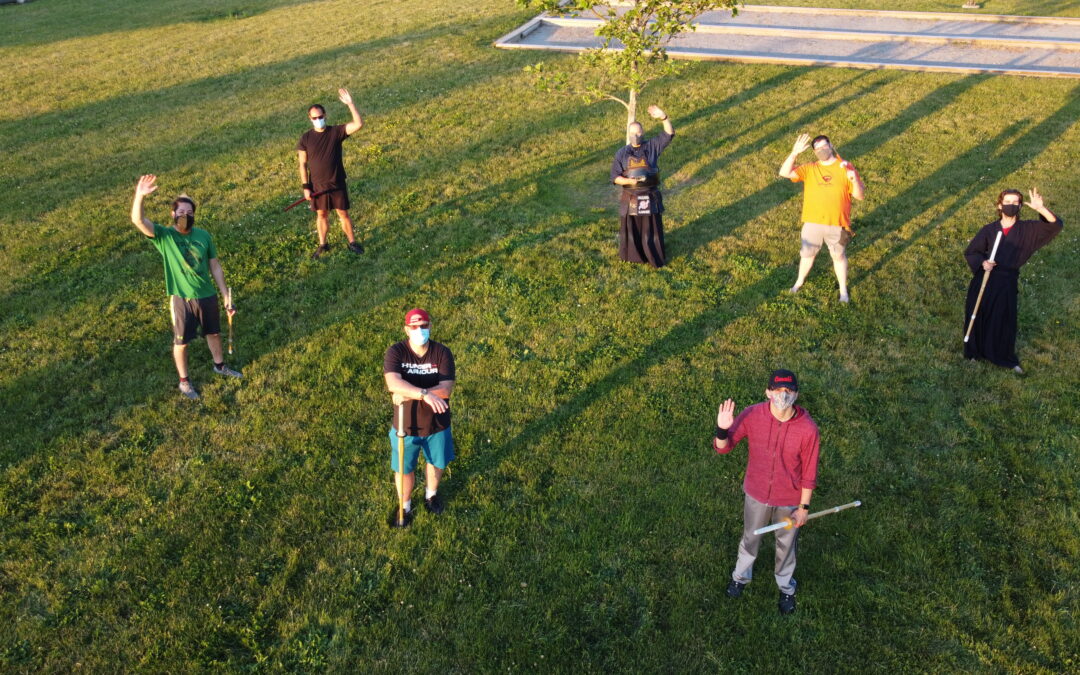These have been challenging times for martial arts dojos, gyms, yoga studios, fitness studios, sports clubs, and all manner of businesses and organizations. As Ontario moves toward “Step 3” of its reopening plan, it seems we will be able to move indoors again. Outdoor training’s been hit and miss (pardon the pun) between heat and weather conditions. What will our kendo training look like next week once we’re back in the great indoors?
Not Yet “Normal”
I think it seems likely we’ll be able to get closer to resuming our usual activities, with some exceptions.
If you would like to read the reopening regulations, here’s the link: https://www.ontario.ca/laws/regulation/r21520
The Step 3 restrictions allow facilities to reopen with capacity limits. The total number of people in the room must be no more than can maintain 2 metres of separation and in no case can it be greater than 50% of the total room capacity. We’ll be fine as I believe the hall’s maximum capacity is at least 100 people.
Masking?
Yep. Masking is still in place. “Every person on the premises of a business or organization that is open shall wear a mask or face covering in a manner that covers their mouth, nose and chin during any period in which they are in an indoor area of the premises.”
We did this before, so we’ll keep on doing it.
Physical Distancing?
Here’s where things get interesting.
What is a martial arts club? Is it in the category of “personal physical fitness trainers”, or perhaps might it fall under the category of “businesses that provide teaching and instruction”?
I don’t know. Perhaps both.
To me, “personal physical fitness trainers” are either working individually with clients or are working in a group fitness class. Participants in group fitness classes don’t move too far from their defined spot, like a yoga mat, for example. Participants in Zumba classes don’t seem to move far either, and when they move, they’re moving in unison.
The regulations for physical fitness instruction require that participants maintain a minimum 2 metre distance from others in the space.
In the category of “businesses that provide in-person teaching and instruction”, the 2 metres distancing regulation is still in place “. . . except where necessary for teaching and instruction that cannot be effectively provided if physical distancing is maintained.”
Hmm.
For the purposes of kendo instruction, it is necessary to be within 2 metres of a training partner to learn how to strike properly. Since the club’s main activity is kendo teaching and instruction, I’m inclined to follow the “in-person teaching and instruction” guidelines. Doing so would mean we could do all of our standard drills. I think this is reasonable, especially because we would still be masking and making other adjustments to our techniques.
I heard public health officials in another Ontario jurisdiction have given permission for a jiujitsu club to re-open and engage in full grappling techniques because it is an integral part of the activity. It stands to reason that if people can grapple while masked, they should be able to hit each other with shinai or swing a bokuto at each other while masked.
Other Adjustments
For those doing keiko (sparring), we’ll be making a few changes based on the Canadian Kendo Federation’s recommendations for protocols for returning to practice.
- All participants in keiko must wear an eye shield, mouth shield, and wear a mask that covers the nose and mouth underneath the men (helmet)
- Limit kiai
- Implement hiki-waza instead of staying in tsubazeriai
- Keiko will be initially limited to 30 minutes maximum per class until students become accustomed to doing keiko while masked
Students who have progressed to basic striking drills will still need to be masked and limit kiai. We will also take some additional time between drills to allow people to get their breath back.
Those doing Bokuto Ni Yoru Kendo Kihon-waza Keiko-ho will also have to remain masked and limit kiai. These drills are less strenuous so we should be able to move through them at a relatively normal pace.
Is This the Way?
In addition to the “usual” cleaning and sanitization we’ve been doing during the pandemic, I think these measures will be effective. Today there was one new case of Covid-19 reported in Niagara. Most of our adult students have had at least one dose of vaccine. I think the risks are low enough that we can move into a more normal approach to kendo with the above measures in place.
Of course, if I receive new information or someone shares a different perspective with me that contradicts what I’ve outlined above, I’ll make adjustments to how we run training sessions. Ultimately I want everyone to be safe and healthy. I think the measures outlined above will be sufficient to minimize the risk of contracting Covid-19 during kendo practice while allowing us to return to more normal training methods.
Hopefully we’ll be able to implement this next week. Until then, thanks for reading. Please share your perspectives. Stay well, and I hope we will cross swords soon!


I think this sounds extremely well versed. Your previsions will allow new students like myself to train and have the standard student/sensei relationship.
I look forward to continuing my Kendo journey